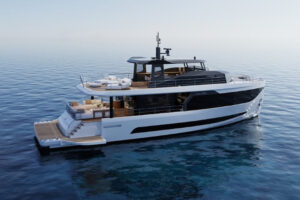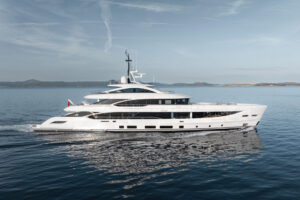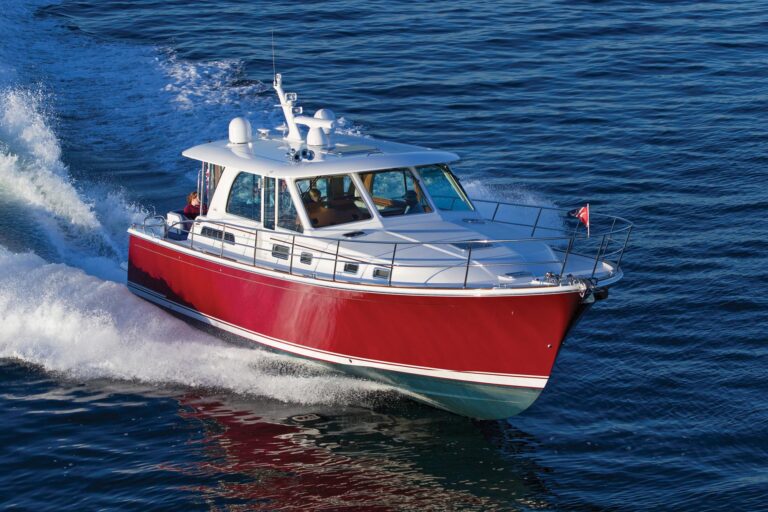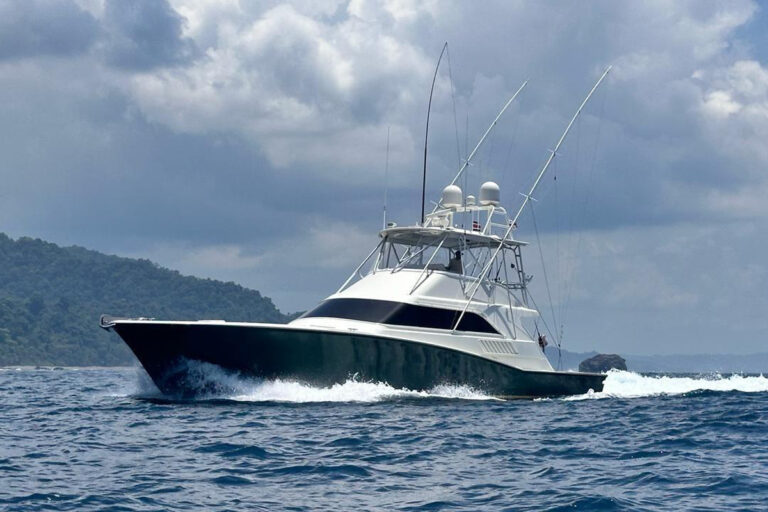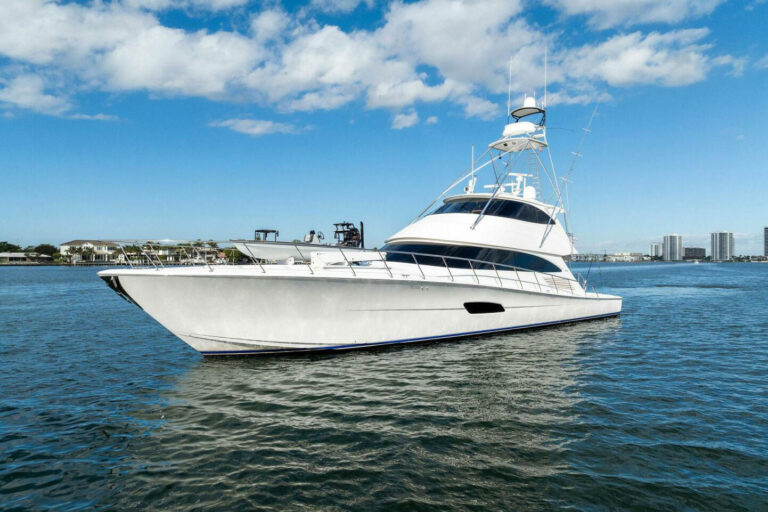Bill Garden is a happy man. The chief designer of the Pacific Mariner 85 sits at his drawing board on tiny, forested Toad Island, a rustic one-house rocky outpost off the western Canadian shore. Garden should be content. Comfortably past 80 now, he’s still drawing winners like the one that just rocketed past his remote design center at nearly 27 knots, quietly carving high-speed turns in the still waters.
There is a price to pay, though, for Garden’s contentment. And Dave Beck, the Pacific Mariner service manager who provides a 24-hour, seven-day-a-week cell-phone number and promises immediate response to any problems, pays it. Like the Maytag Man, Beck has a lonely existence: He rarely gets a call from Pacific Mariner owners. After launching more than 50 65-footers and now building the fifth 85, Beck maintains a fleet that’s cruising the waters of the world, and yet he has a quiet life.
Buy a Pacific Mariner, and all you need are groceries and you’re ready to cruise. After a five- to seven-day vessel orientation, similar to a private master class in systems, boat operation and construction, the proud new owners of the 85 walk aboard with Dave Beck’s card and all his contact information, and the promise to service their boat anywhere, anytime. Which should say it all, really. Except that Beck wants to explain how it’s accomplished. “The owner’s manual has warranties on page one and on page two, all my numbers and how to reach us anytime,” he says. “We’ve been a production boat yard for 10 years, and the entire time we’ve been servicing our boats we’ve been listening to our customers, incorporating their needs into our designs. And we’ve continued to perfect construction techniques. Rather than dealing with the front-end headaches of custom designs we’ve used feedback to hone production. These boats are each known quantities, everything we say they are. Trouble-free doesn’t just happen.”
Say “production” boat and someone might think “plain vanilla in a Ben and Jerry’s world.” But not with these. Neither dull nor set in their ways, these boats have pizazz. Fast, quiet, and luxuriously appointed, they are built using composite construction techniques that exceed what you will find in most of the world’s custom megayacht yards.
After Garden penciled another classic hull with his typical fine entry, Jack Edson, co-owner of Pacific Mariner, turned to Greg Marshall, who’d worked under Garden for eight years, as stylist and designer. Marshall computerized the shape of the new 85 and created interior layouts for the emerging speedster.
In Garden’s designs, “weight creep” is closely monitored to lift the bow and control the aft sections where engines and tankage dominate. Garden’s notably fine entry, low profile and full stern sections achieve this. The relatively far aft center of buoyancy helps a high-performance shape slice cleanly through the seas and carve skate turns with ease. Strong gull-wing chines provide lift to help dry the ride as does the flattening of the hull form. This shape is all made possible by a sophisticated composite layup that includes an Airex-cored hull and Corecell stringers for longitudinal stiffness, as well as cored deck and bulkheads to form a rigid structure with a solid fiberglass bottom.
The 85 is smoother and lighter and costs less because it is built in fewer pieces. Where an 85-footer from another builder might be fabricated with 30 separate pieces, the Pacific Mariner 85 is built with six. That’s right. The entire deck, superstructure and swim step approach is one piece. Janicki, one of the world’s leading tooling developers, is located a few miles from Pacific Mariner and produces its tooling with a five-axis computer-shaping machine. “It was a thing of beauty when that deck just clicked into place,” recalls Edson.
The beauty is more than skin deep, says Marshall. “It costs more to develop the tooling out front this way, but for a production boat it produces not only the greatest quality and structural integrity, but is also the most cost efficient in the long production run.” Other advantages are fewer joints to fair or leak and a stronger and stiffer structure. “Because 20 percent of a fiberglass boat’s weight is in secondary bonding, this technique reduces the weight and the operation costs,” says Marshall.
Out goes the weight and up goes the speed. Fast is fun. It was Bill Lee, a sailor from Santa Cruz, who coined the phrase in the ’60s as he awakened the sailing world to the simple joys of speed and launched a revolution in boat design. Garden, a true believer that a boat should look and handle with style and spunk, not like an RV stuck in the mud, is his powerboat counterpart-though lacking the barefoot Southern California style. But when it comes to speed, the Pacific Mariner 85 is all of that.
Powered by twin MTU 12V2000s with 1,500 hp each and carrying 2,350 gallons of fuel-more than twice that of the 65-the 85 can reach a range of more than 1,000 miles cruising at 10 to 12 knots. Or she can get you there in less than half the time.
Push the throttle and feel the acceleration as your back pushes against the seat, the bow lifts, the boat charges ahead and caramba! The 27-knot blast at the top end is almost too much-almost sinful for a sprawling luxury yacht to be this much fun to drive. And while many yachts can hit these speeds and more, many seem to make compromises in either comfort, efficiency, stability, cost or noise. The Pacific Mariner hits 27 in stride. Quietly.
Indeed, what makes a Pacific Mariner so livable is its quiet ride, which Edson says is the source of more owner praise than any other feature. Constant improvement to the sound and vibration package is a goal of development and production, the ease of isolating issues being one of the great advantages of consistency. SounDown insulation in the engineroom and 3M Thinsulate isolates the living spaces, along with sound shields, special carpet pads and in-line silencers, isolation mounts for engine and generator supports, and vectored cowls for underwater exhausts and AC cooling discharge. Overall, Pacific Mariner is an aggressively silenced yacht and can lay claims to being the quietest ride in its class-something that sells boats when whispered during a test ride.
Family is fun too, as Edson says, “We’ve created the 85 to suit many tastes, but our central market has always been the owner-operated cruising family yacht with the ability for short-handed operation.” To accommodate that family experience there are four staterooms, each with its own head, and a penthouse of a raised pilothouse for supreme visibility. The galley is combined with a raised dining/seating area and a wheelhouse with swiveling Stidd chairs to form one long panoramic gallery space; it transforms cruising into a participatory rite for all aboard, no matter whether cook, guest or captain.
The smooth, quiet ride is appreciated topside, but most important, inside, when you are surrounded by the luxurious interior of satin-finished cherry with sapele and teak accents and classic moldings. A large L-shaped settee in the main saloon faces the full wet bar to starboard and an eight-place dining settee. The forward bulkhead provides an entertainment center with buffet, 50-inch plasma-screen TV, sound system and glass display cabinets. The aft bulkhead is glass with sliding doors and opens to a California deck with a spiral stairway to the upper deck. A private saloon stairway forward of the bar leads to the full-width master suite with king berth, desk, vanity and a roomy head with full-sized spa tub, twin sinks and shower. Windows and views dominate the walk forward past the galley’s granite counters, the day head to starboard and the full-beam pilothouse. A curved stairway leads to three forward staterooms, with a private head for the queen VIP stateroom; two others can be adapted to multiple configurations.
For those owners who prefer crew at times, or grandchildren, there is an expanded crew area aft with a galley, double cabin and captain’s stateroom. Mary Poppins would approve.
Walking through the yacht you have to keep reminding yourself that this production boat has few options, but eight pages of standard items. “It is another result of our building and ordering in production quantities without the drain of custom changes,” says Edson. “And our purchasing ability allows us to get top-quality items for low cost and pass that on to the consumer.”
Nowhere is this more visible than in the fully appointed wheelhouse that comes complete with an electronics package that few custom builders could beat. The arrangement of well-lit access panels and backup systems makes it adaptable should the need to replace an item arise, a sure thing in today’s world of rapid technological changes.
A pilothouse stairway leads to one of the most comfortable and social flying bridges of any boat under 100 feet: Guests get to loll in three Stidd chairs, a spacious curved settee and a large hot tub, helping themselves to a full-service wet bar and barbecue station. There’s enough room topside to handle a tender of almost any configuration. Two wing stations straddle the central full-panel dash and, combined with the aft docking control off the main deck, bring to five the total number of steering stations. Beyond the sweeping wraparound windscreen is the broad flat foredeck with its extra-wide side decks: another user-friendly touch.
As opposed to the earlier chiseled 65 with its white mullions, the 85 has a softer, more rakish look, thanks to its smooth black windows. “When you develop a production design you use classic features to invite long-lasting appeal. To get there, we went through ten or twelve profiles and eliminated any potentially objectionable elements.” For instance, a visor was added to make the windscreen more inviting. But the windshield itself is not too steep, since too radical an angle can result in windows that are difficult to see through and to maintain. Walk-around decks and an expansive flying bridge allow sight lines from all points on deck for short-handed docking.
The engineroom is another area that should make the 85 a dream to operate: Pacific Mariner has placed access hatches everywhere, eliminated extraneous piping runs to save weight and maximize performance and moved every item close to the centerline.
Eventually the marvel of this production sinks in-and we use the word in the sense of, say, a traveling Broadway musical or Rolling Stones road show. Order now and you can expect to take delivery in eight months-that’s for the complete turnkey presentation, right down to the pillows, electronics and barbecue forks. No extra charge for the thrill of parting the seas with its razor entry, and then keeping it up for miles and miles.
Contact: Pacific Mariner, www.pacificmariner.com


